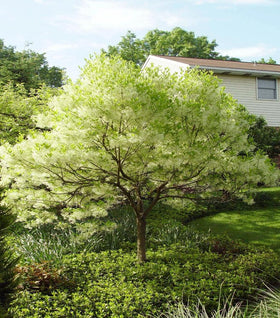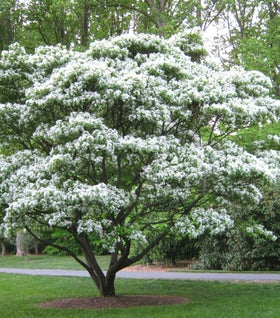Fringe Trees
Looking for a refined spring show with effortless care? Fringe trees (Chionanthus) deliver fragrant, lacey white blooms that float like confetti over glossy foliage, then settle into a clean, well-behaved silhouette for the rest of the season. We curate native fringe tree (Chionanthus virginicus) for habitat value and Chinese fringe tree (C. retusus) for polished branching—both proven performers in real landscapes.
When you buy fringe trees online from Garden Goods Direct, you get nursery-grown, zone-appropriate stock with straightforward and honest guidance on planting, spacing, and siting—backed by our "We Grow Together" Promise. Pair your tree with dark evergreen shrubs, weave in deer-resistant perennials, and add pollinator plants to create a spring focal point that keeps paying off through summer and fall.
Why Choose Fringe Trees: Fragrant Spring Clouds, Polished Form & Low Maintenance
Fringe trees bring an elegant, high-impact bloom right when you want it most—late spring into early summer—followed by glossy, disease-resistant foliage that reads tidy in foundation beds and mixed borders. The lace-like flowers are showy from a distance yet delicate up close, making them equally at home in front yards, courtyards, and entry plantings.
Habit & Seasonal Interest: Lacy Blossoms, Glossy Summer Foliage, Subtle Fall Color
Bloom: Cascades of fragrant, fringe-like white flowers that light up the canopy.
Foliage: Clean, lustrous leaves hold color through heat; many selections warm to buttery yellow in fall.
Structure: Naturally rounded to oval crowns with fine branching—minimal pruning required and four-season poise in smaller spaces.
Native vs. Chinese Fringe Tree: Which One is Right for Your Yard?
Native Fringe Tree (Chionanthus virginicus): A North American native with strong wildlife value; soft, natural branching; excellent choice near woodland edges or pollinator gardens.
Chinese Fringe Tree (C. retusus): Slightly more formal architecture with denser branching and a polished look—great for front entries, patios, and streetside planting.
Design That Works: Front-Entry Statements, Understory Partners & Pollinator Payoff
Front Door Focus: Center a fringe tree in a lawn panel or bed island; back it with evergreens to make blooms glow.
Understory Layers: Combine with azaleas, hydrangeas, and hostas where dappled light keeps textures lush.
Wildlife Support: Native fringe pairs naturally with pollinator perennials, providing nectar and seasonal shelter.
Fringe Tree Planting & Care Made Simple: Sun, Soil, Spacing & Pruning
Planting: Plant in full sun to part shade with well-drained soil. Set the root flare at or slightly above grade, backfill with native soil, water deeply, and mulch 2–3″ (pulled back from the trunk). Keep evenly moist during the first season; once established, fringe trees are low-maintenance with modest drought tolerance.
Pruning: Minimal—remove dead or crossing wood after bloom or in late winter.
Spacing (quick guide): Specimens 8–12 ft from structures; groupings 10–15 ft on center depending on cultivar and desired canopy overlap.
Round out the landscape with Evergreen Trees for a dark backdrop, and add Deer-Resistant Perennials for low-care texture, and weave in Pollinator Plants
to maximize spring activity around your fringe tree.


